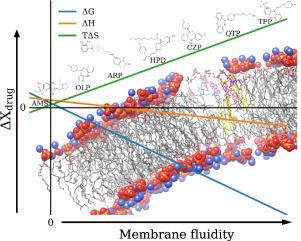当前位置:
X-MOL 学术
›
Chem. Phys. Lipids
›
论文详情
Our official English website, www.x-mol.net, welcomes your
feedback! (Note: you will need to create a separate account there.)
The effect of neuroleptic drugs on DPPC/sphingomyelin/cholesterol membranes.
Chemistry and Physics of Lipids ( IF 3.4 ) Pub Date : 2020-04-23 , DOI: 10.1016/j.chemphyslip.2020.104913 R Pérez-Isidoro 1 , M Costas 1
Chemistry and Physics of Lipids ( IF 3.4 ) Pub Date : 2020-04-23 , DOI: 10.1016/j.chemphyslip.2020.104913 R Pérez-Isidoro 1 , M Costas 1
Affiliation

|
The hydrophobic nature of neuroleptic drugs renders that these molecules interact not only with protein receptors, but also with the lipids constituting the membrane bilayer. We present a systematic study of the effect of seven neuroleptic drugs on a biomembrane model composed of DPPC, sphingomyelin, and cholesterol. Differential scanning calorimetry (DSC) measurements were used to monitor the gel-fluid phase transition of the lipid bilayer at three pH values and also as a function of drug concentration. The implementation of a new methodology to mix lipids homogeneously allowed us to assemble bilayers completely free of organic solvents. The seven neuroleptics were: trifluoperazine, haloperidol decanoate, clozapine, quetiapine, olanzapine, aripiprazole, and amisulpride. The DSC results show that the insertion of the drug into the bilayer produces a fluidization and a disordering of the bilayer. The bilayer perturbation is qualitatively the same for all the studied drugs, but quantitatively different. The driving force for the neuroleptic drug to place itself in the lipid bilayer is entropic in nature, signaling to the importance of the size and geometry of the drugs. The drug protonated species produce stronger effects than their non-protonated forms. At high concentrations two of the neuroleptics revert the fluidization effect and another completely abolishes the gel-fluid transition. The DSC data and the associated discussion contribute to the understanding of the interactions between neuroleptic drugs and lipid membranes.
中文翻译:

抗精神病药对DPPC /鞘磷脂/胆固醇膜的影响。
抗精神病药的疏水性使得这些分子不仅与蛋白质受体相互作用,而且与构成膜双层的脂质相互作用。我们目前对由DPPC,鞘磷脂和胆固醇组成的生物膜模型上的七种抗精神病药的作用进行系统研究。差示扫描量热法(DSC)测量用于监测在三个pH值下脂质双层的凝胶-流体相变以及药物浓度的函数。一种将脂质均匀混合的新方法的实施使我们能够组装完全不含有机溶剂的双层薄膜。七种抗精神病药是:氟哌丁嗪,氟哌啶醇癸酸酯,氯氮平,喹硫平,奥氮平,阿立哌唑和氨磺必利。DSC结果表明,将药物插入双层中会引起双层的流化和无序。对于所有研究的药物,双层扰动在质量上是相同的,但是在数量上是不同的。抗精神病药将其自身置于脂质双层中的驱动力本质上是熵的,这表明药物的大小和几何形状很重要。药物质子化的物质比非质子化的形式产生更强的作用。在高浓度下,两种抗精神病药可逆转流化作用,而另一种则可完全消除凝胶-流体过渡。DSC数据和相关讨论有助于理解抗精神病药与脂质膜之间的相互作用。对于所有研究的药物,双层扰动在质量上是相同的,但是在数量上是不同的。抗精神病药将其自身置于脂质双层中的驱动力本质上是熵的,这表明药物的大小和几何形状很重要。药物质子化种类比非质子化形式产生更强的作用。在高浓度下,两种抗精神病药可逆转流化作用,而另一种则可完全消除凝胶-流体的转变。DSC数据和相关讨论有助于理解抗精神病药与脂质膜之间的相互作用。对于所有研究的药物,双层扰动在质量上是相同的,但是在数量上是不同的。抗精神病药将其自身置于脂质双层中的驱动力本质上是熵的,这表明药物的大小和几何形状很重要。药物质子化的物质比非质子化的形式产生更强的作用。在高浓度下,两种抗精神病药可逆转流化作用,而另一种则可完全消除凝胶-流体的转变。DSC数据和相关讨论有助于理解抗精神病药与脂质膜之间的相互作用。表示药物尺寸和几何形状的重要性。药物质子化的物质比非质子化的形式产生更强的作用。在高浓度下,两种抗精神病药可逆转流化作用,而另一种则可完全消除凝胶-流体过渡。DSC数据和相关讨论有助于理解抗精神病药与脂质膜之间的相互作用。表示药物尺寸和几何形状的重要性。药物质子化的物质比非质子化的形式产生更强的作用。在高浓度下,两种抗精神病药可逆转流化作用,而另一种则可完全消除凝胶-流体的转变。DSC数据和相关讨论有助于理解抗精神病药与脂质膜之间的相互作用。
更新日期:2020-04-23
中文翻译:

抗精神病药对DPPC /鞘磷脂/胆固醇膜的影响。
抗精神病药的疏水性使得这些分子不仅与蛋白质受体相互作用,而且与构成膜双层的脂质相互作用。我们目前对由DPPC,鞘磷脂和胆固醇组成的生物膜模型上的七种抗精神病药的作用进行系统研究。差示扫描量热法(DSC)测量用于监测在三个pH值下脂质双层的凝胶-流体相变以及药物浓度的函数。一种将脂质均匀混合的新方法的实施使我们能够组装完全不含有机溶剂的双层薄膜。七种抗精神病药是:氟哌丁嗪,氟哌啶醇癸酸酯,氯氮平,喹硫平,奥氮平,阿立哌唑和氨磺必利。DSC结果表明,将药物插入双层中会引起双层的流化和无序。对于所有研究的药物,双层扰动在质量上是相同的,但是在数量上是不同的。抗精神病药将其自身置于脂质双层中的驱动力本质上是熵的,这表明药物的大小和几何形状很重要。药物质子化的物质比非质子化的形式产生更强的作用。在高浓度下,两种抗精神病药可逆转流化作用,而另一种则可完全消除凝胶-流体过渡。DSC数据和相关讨论有助于理解抗精神病药与脂质膜之间的相互作用。对于所有研究的药物,双层扰动在质量上是相同的,但是在数量上是不同的。抗精神病药将其自身置于脂质双层中的驱动力本质上是熵的,这表明药物的大小和几何形状很重要。药物质子化种类比非质子化形式产生更强的作用。在高浓度下,两种抗精神病药可逆转流化作用,而另一种则可完全消除凝胶-流体的转变。DSC数据和相关讨论有助于理解抗精神病药与脂质膜之间的相互作用。对于所有研究的药物,双层扰动在质量上是相同的,但是在数量上是不同的。抗精神病药将其自身置于脂质双层中的驱动力本质上是熵的,这表明药物的大小和几何形状很重要。药物质子化的物质比非质子化的形式产生更强的作用。在高浓度下,两种抗精神病药可逆转流化作用,而另一种则可完全消除凝胶-流体的转变。DSC数据和相关讨论有助于理解抗精神病药与脂质膜之间的相互作用。表示药物尺寸和几何形状的重要性。药物质子化的物质比非质子化的形式产生更强的作用。在高浓度下,两种抗精神病药可逆转流化作用,而另一种则可完全消除凝胶-流体过渡。DSC数据和相关讨论有助于理解抗精神病药与脂质膜之间的相互作用。表示药物尺寸和几何形状的重要性。药物质子化的物质比非质子化的形式产生更强的作用。在高浓度下,两种抗精神病药可逆转流化作用,而另一种则可完全消除凝胶-流体的转变。DSC数据和相关讨论有助于理解抗精神病药与脂质膜之间的相互作用。











































 京公网安备 11010802027423号
京公网安备 11010802027423号